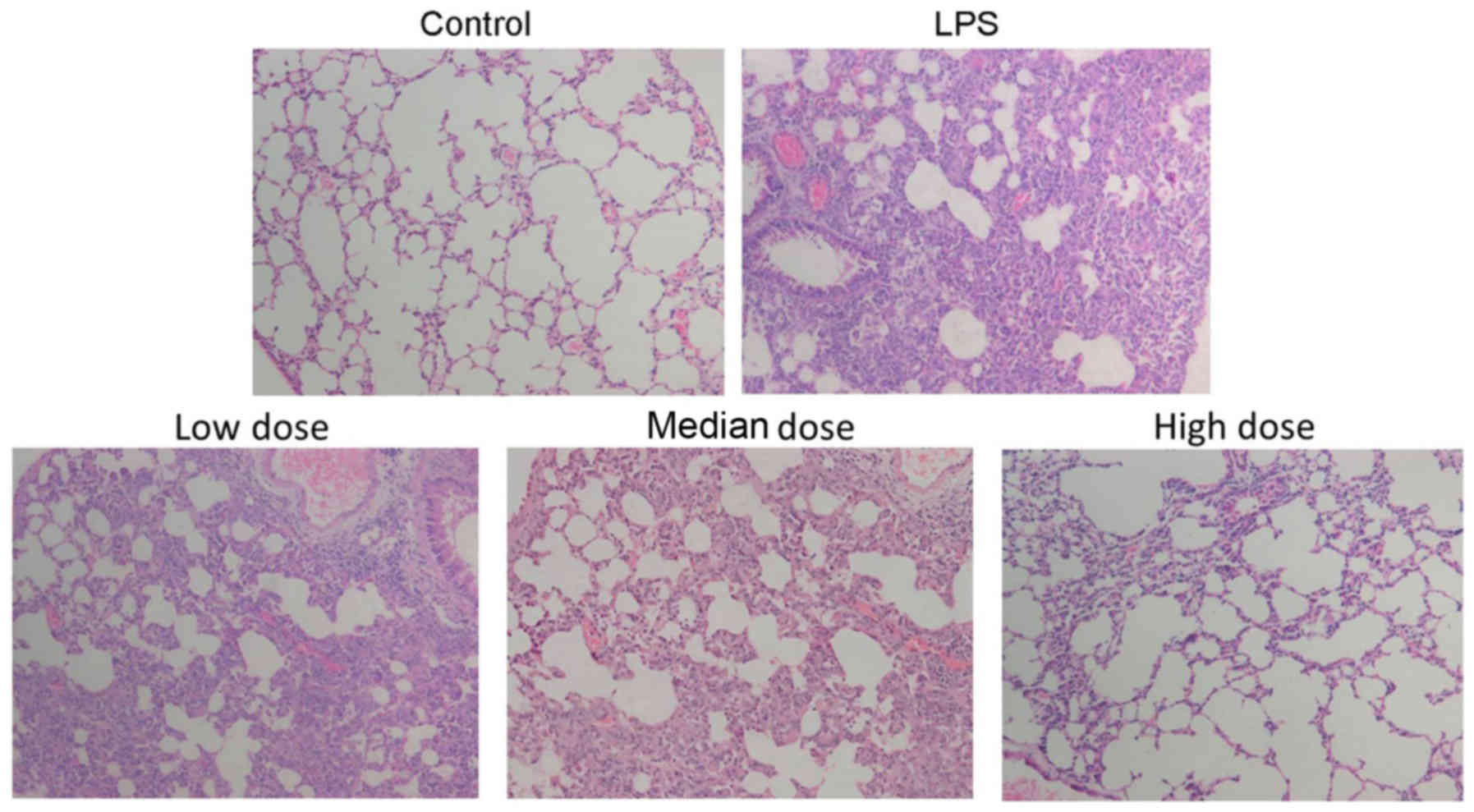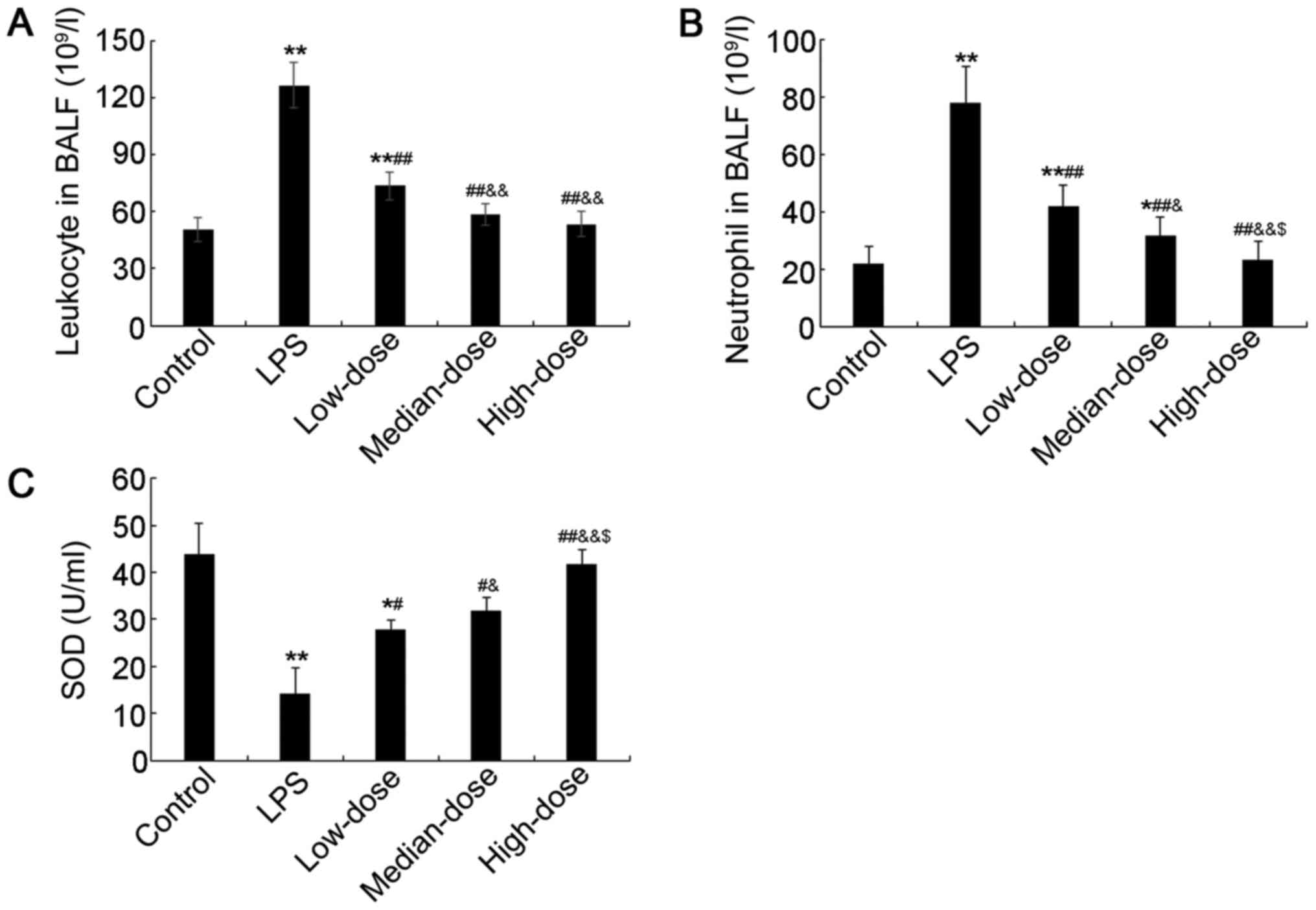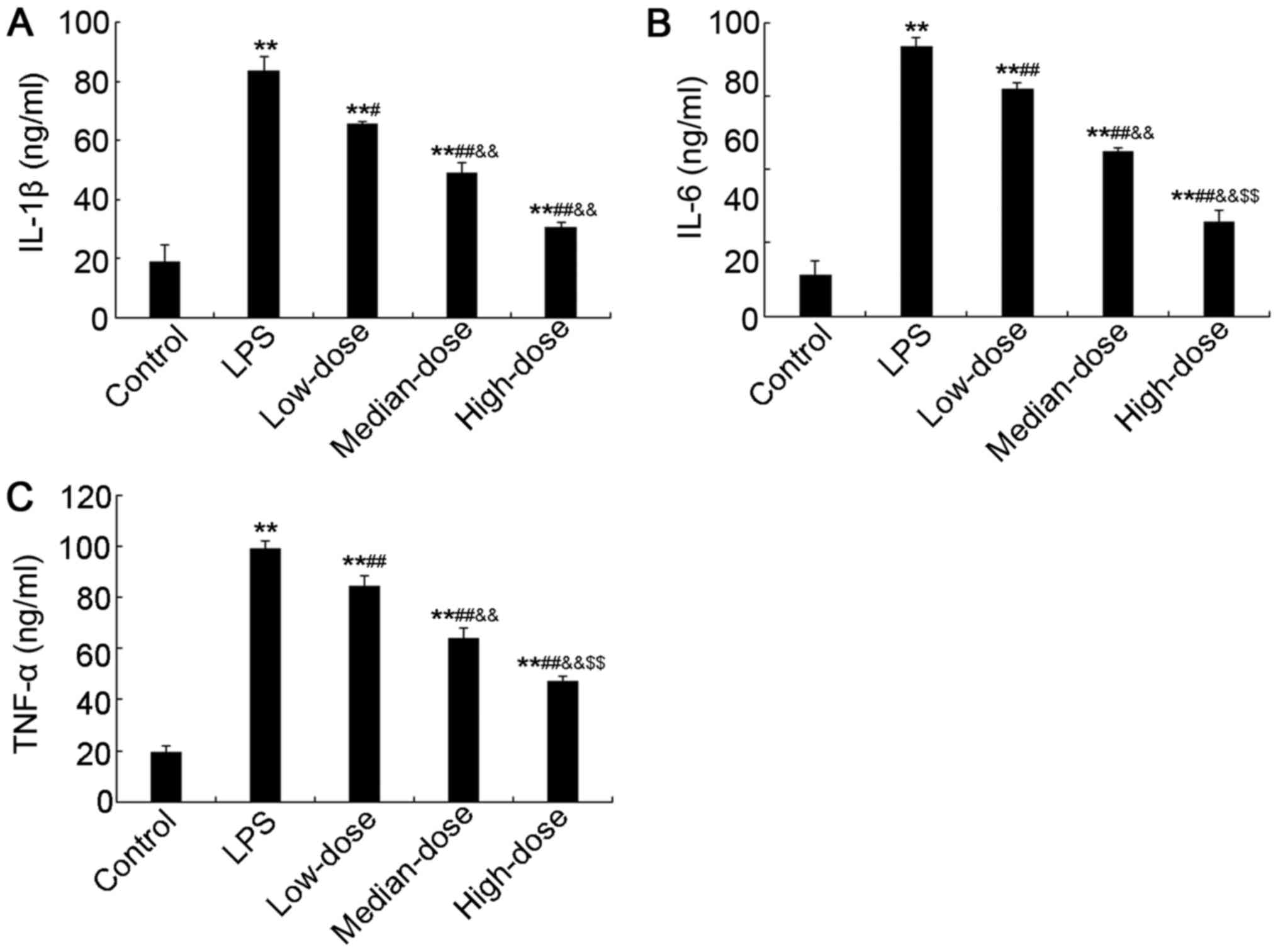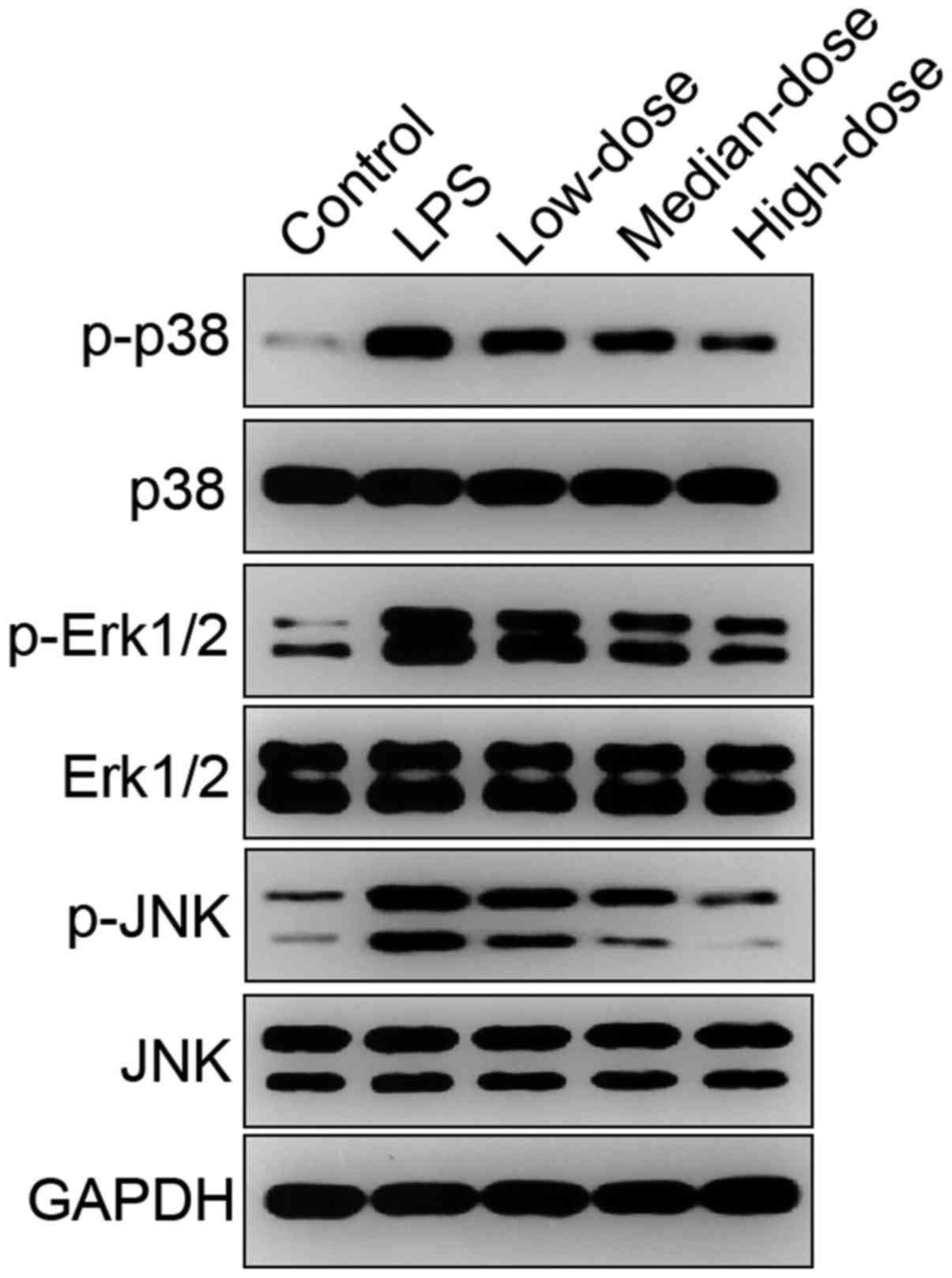|
1
|
Chen T, Mou Y, Tan J, Wei L, Qiao Y, Wei
T, Xiang P, Peng S, Zhang Y, Huang Z and Ji H: The protective
effect of CDDO-Me on lipopolysaccharide-induced acute lung injury
in mice. Int Immunopharmacol. 25:55–64. 2015. View Article : Google Scholar : PubMed/NCBI
|
|
2
|
Tao W, Su Q, Wang H, Guo S, Chen Y, Duan J
and Wang S: Platycodin D attenuates acute lung injury by
suppressing apoptosis and inflammation in vivo and in vitro. Int
Immunopharmacol. 27:138–147. 2015. View Article : Google Scholar : PubMed/NCBI
|
|
3
|
Zhong W, Cui Y, Yu Q, Xie X, Liu Y, Wei M,
Ci X and Peng L: Modulation of LPS-stimulated pulmonary
inflammation by Borneol in murine acute lung injury model.
Inflammation. 37:1148–1157. 2014. View Article : Google Scholar : PubMed/NCBI
|
|
4
|
Jiang W, Luo F, Lu Q, Liu J, Li P, Wang X,
Fu Y, Hao K, Yan T and Ding X: The protective effect of Trillin
LPS-induced acute lung injury by the regulations of inflammation
and oxidative state. Chem Biol Interact. 243:127–134. 2016.
View Article : Google Scholar : PubMed/NCBI
|
|
5
|
Lee I, Dodia C, Chatterjee S, Feinstein SI
and Fisher AB: Protection against LPS-induced acute lung injury by
a mechanism-based inhibitor of NADPH oxidase (type 2). Am J Physiol
Lung Cell Mol Physiol. 306:L635–L644. 2014. View Article : Google Scholar : PubMed/NCBI
|
|
6
|
Do-Umehara HC, Chen C, Urich D, Zhou L,
Qiu J, Jang S, Zander A, Baker MA, Eilers M, Sporn PH, et al:
Suppression of inflammation and acute lung injury by Miz1 via
repression of C/EBP-δ. Nat Immunol. 14:461–469. 2013. View Article : Google Scholar : PubMed/NCBI
|
|
7
|
Yen YT, Yang HR, Lo HC, Hsieh YC, Tsai SC,
Hong CW and Hsieh CH: Enhancing autophagy with activated protein C
and rapamycin protects against sepsis-induced acute lung injury.
Surgery. 153:689–698. 2013. View Article : Google Scholar : PubMed/NCBI
|
|
8
|
Murakami K, Okajima K, Uchiba M, Johno M,
Nakagaki T, Okabe H and Takatsuki K: Activated protein C prevents
LPS-induced pulmonary vascular injury by inhibiting cytokine
production. Am J Physiol. 272:L197–L202. 1997.PubMed/NCBI
|
|
9
|
Maniatis NA, Letsiou E, Orfanos SE,
Kardara M, Dimopoulou I, Nakos G, Lekka ME, Roussos C, Armaganidis
A and Kotanidou A: Inhaled activated protein C protects mice from
ventilator-induced lung injury. Crit Care. 14:R702010. View Article : Google Scholar : PubMed/NCBI
|
|
10
|
Chesebro BB, Rahn P, Carles M, Esmon CT,
Xu J, Brohi K, Frith D, Pittet JF and Cohen MJ: Increase in
activated protein C mediates acute traumatic coagulopathy in mice.
Shock. 32:659–665. 2009. View Article : Google Scholar : PubMed/NCBI
|
|
11
|
Yunhe F, Bo L, Xiaosheng F, Fengyang L,
Dejie L, Zhicheng L, Depeng L, Yongguo C, Xichen Z, Naisheng Z and
Zhengtao Y: The effect of magnolol on the Toll-like receptor
4/nuclear factor κB signaling pathway in lipopolysaccharide-induced
acute lung injury in mice. Eur J Pharmacol. 689:255–261. 2012.
View Article : Google Scholar : PubMed/NCBI
|
|
12
|
Zhu T, Wang DX, Zhang W, Liao XQ, Guan X,
Bo H, Sun JY, Huang NW, He J, Zhang YK, et al: Andrographolide
protects against LPS-induced acute lung injury by inactivation of
NF-κB. PLoS One. 8:e564072013. View Article : Google Scholar : PubMed/NCBI
|
|
13
|
Jiang Q, Yi M, Guo Q, Wang C, Wang H, Meng
S, Liu C, Fu Y, Ji H and Chen T: Protective effects of polydatin on
lipopolysaccharide-induced acute lung injury through
TLR4-MyD88-NF-κB pathway. Int Immunopharmacol. 29:370–376. 2015.
View Article : Google Scholar : PubMed/NCBI
|
|
14
|
Wang B, Gong X, Wan JY, Zhang L, Zhang Z,
Li HZ and Min S: Resolvin D1 protects mice from LPS-induced acute
lung injury. Pulm Pharmacol Ther. 24:434–441. 2011. View Article : Google Scholar : PubMed/NCBI
|
|
15
|
Liu Y, Wu H, Nie YC, Chen JL, Su WW and Li
PB: Naringin attenuates acute lung injury in LPS-treated mice by
inhibiting NF-κB pathway. Int Immunopharmacol. 11:1606–1612. 2011.
View Article : Google Scholar : PubMed/NCBI
|
|
16
|
Ward PA: Oxidative stress: Acute and
progressive lung injury. Ann N Y Acad Sci. 1203:53–59. 2010.
View Article : Google Scholar : PubMed/NCBI
|
|
17
|
Kim Y, Kim BH, Lee H, Jeon B, Lee YS, Kwon
MJ and Kim TY: Regulation of skin inflammation and angiogenesis by
EC-SOD via HIF-1α and NF-κB pathways. Free Radic Biol Med.
51:1985–1995. 2011. View Article : Google Scholar : PubMed/NCBI
|
|
18
|
Howard MD, Greineder CF, Hood ED and
Muzykantov VR: Endothelial targeting of liposomes encapsulating
SOD/catalase mimetic EUK-134 alleviates acute pulmonary
inflammation. J Control Release. 177:34–41. 2014. View Article : Google Scholar : PubMed/NCBI
|
|
19
|
Park J, Min JS, Kim B, Chae UB, Yun JW,
Choi MS, Kong IK, Chang KT and Lee DS: Mitochondrial ROS govern the
LPS-induced pro-inflammatory response in microglia cells by
regulating MAPK and NF-κB pathways. Neurosci Lett. 584:191–196.
2015. View Article : Google Scholar : PubMed/NCBI
|
|
20
|
He X, Wei Z, Zhou E, Chen L, Kou J, Wang J
and Yang Z: Baicalein attenuates inflammatory responses by
suppressing TLR4 mediated NF-κB and MAPK signaling pathways in
LPS-induced mastitis in mice. Int Immunopharmacol. 28:470–476.
2015. View Article : Google Scholar : PubMed/NCBI
|
|
21
|
Hirose K, Okajima K, Taoka Y, Uchiba M,
Tagami H, Nakano K, Utoh J, Okabe H and Kitamura N: Activated
protein C reduces the ischemia/reperfusion-induced spinal cord
injury in rats by inhibiting neutrophil activation. Ann Surg.
232:272–280. 2000. View Article : Google Scholar : PubMed/NCBI
|
|
22
|
Bischofberger AS, Tsang AS, Horadagoda N,
Dart CM, Perkins NR, Jeffcott LB, Jackson CJ and Dart A: Effect of
activated protein C in second intention healing of equine distal
limb wounds: A preliminary study. Aust Vet J. 93:361–366. 2015.
View Article : Google Scholar : PubMed/NCBI
|
|
23
|
Amar AP, Griffin JH and Zlokovic BV:
Combined neurothrombectomy or thrombolysis with adjunctive delivery
of 3K3A-activated protein C in acute ischemic stroke. Front Cell
Neurosci. 9:3442015. View Article : Google Scholar : PubMed/NCBI
|
|
24
|
Zhang Z: The efficacy of activated protein
C for the treatment of sepsis: Incorporating observational evidence
with a Bayesian approach. BMJ Open. 5:e0065242015. View Article : Google Scholar : PubMed/NCBI
|
|
25
|
Allison SJ: Acute kidney injury: Activated
protein C protective in IRI. Nat Rev Nephrol. 11:4452015.
View Article : Google Scholar : PubMed/NCBI
|
|
26
|
Nick JA, Coldren CD, Geraci MW, Poch KR,
Fouty BW, O'Brien J, Gruber M, Zarini S, Murphy RC, Kuhn K, et al:
Recombinant human activated protein C reduces human
endotoxin-induced pulmonary inflammation via inhibition of
neutrophil chemotaxis. Blood. 104:3878–3885. 2004. View Article : Google Scholar : PubMed/NCBI
|
|
27
|
Shi Q, Cao J, Fang L, Zhao H, Liu Z, Ran
J, Zheng X, Li X, Zhou Y, Ge D, et al: Geniposide suppresses
LPS-induced nitric oxide, PGE2 and inflammatory cytokine by
downregulating NF-κB, MAPK and AP-1 signaling pathways in
macrophages. Int Immunopharmacol. 20:298–306. 2014. View Article : Google Scholar : PubMed/NCBI
|
|
28
|
Liang D, Li F, Fu Y, Cao Y, Song X, Wang
T, Wang W, Guo M, Zhou E, Li D, et al: Thymol inhibits
LPS-stimulated inflammatory response via down-regulation of NF-κB
and MAPK signaling pathways in mouse mammary epithelial cells.
Inflammation. 37:214–222. 2014. View Article : Google Scholar : PubMed/NCBI
|













